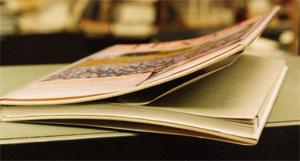Warped Book Covers
 One summer many years ago the University I taught at in New York State decided to “save” money and turn-off the air conditioning units. I was not concerned because my classes that summer were conducted in labs down in the basement. However, it did not take long before the curator of the rare book library started to be very concerned. Books bound in parchment, some over 500 years old, started to “move.” That is, the covers started to warp outwards, in some occasions breaking the slip cases. What was going on?
One summer many years ago the University I taught at in New York State decided to “save” money and turn-off the air conditioning units. I was not concerned because my classes that summer were conducted in labs down in the basement. However, it did not take long before the curator of the rare book library started to be very concerned. Books bound in parchment, some over 500 years old, started to “move.” That is, the covers started to warp outwards, in some occasions breaking the slip cases. What was going on?
We often take non-warping hard cover bindings for granted. However, I’m sure that many of our readers have experienced some books with warped covers, especially in the winter when the moisture content of the air is extremely low. You may ask, why does warping happen and why does it seem to affect some books more than others? (It is not because of the use of “warp-free binders boards” as you sometimes see advertised. There is no such thing!)
Why some covers warp is a complex question to answer because there are many factors involved. The main reason book covers warp is due to an imbalance of forces. Moisture is being taken on or given off at different rates by the various materials that make up the book. For example, a publisher’s edition may use the paper the content is printed on as an endpaper rather than special endpapers. This type of paper may grow and shrink in an uncontrolled manner, and at a much different rate than the board it is adhered to. What’s worse, if the paper grain direction is perpendicular to the binding edge, you have a sure recipe for disaster.
Perhaps the most important factor in keeping book covers flat is the environment. The Library of Congress, in a preservation leaflet, recommends an “ideal” temperature range of 55 to 70 degrees and a relative humidity of 40 to 50 percent. However LC admits that the upper temperature range is more realistic because no person wants to be in a library that’s at 55 degrees!
If you do find yourself with some warped covers here are some “hints” that may be helpful.
Problem: If books dry out in the winter due to low humidity or in the summer due to high heat, the covers may warp.
Solution: Take clean tap water. With a sponge, apply a thin coat of water onto the insides of the covers. Be careful when the text blocks consist of coated paper stock. If that is the case, insert a moisture barrier such as a sheet of mylar. (This is what we did with those parchment covered rare books in the university library.) Overnight, leave a heavy weight covering the entire book.
Problem: The book was put on display for weeks. After being open and fanned out for so long, it will no longer close.
Solution: Insert book into a press or place some heavy books on top of it. If fanned out, the sheets do become “wavy,” especially if the content is cross-grained. Pressing will put it back into its original condition.
